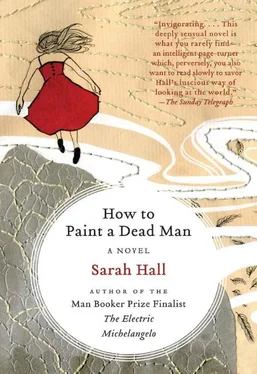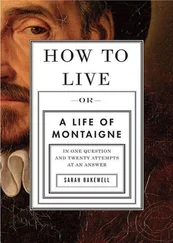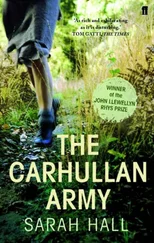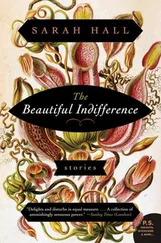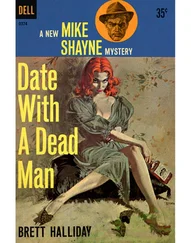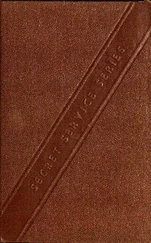Sarah Hall - How to Paint a Dead Man
Здесь есть возможность читать онлайн «Sarah Hall - How to Paint a Dead Man» весь текст электронной книги совершенно бесплатно (целиком полную версию без сокращений). В некоторых случаях можно слушать аудио, скачать через торрент в формате fb2 и присутствует краткое содержание. Год выпуска: 2009, Издательство: Harper Perennial, Жанр: Современная проза, на английском языке. Описание произведения, (предисловие) а так же отзывы посетителей доступны на портале библиотеки ЛибКат.
- Название:How to Paint a Dead Man
- Автор:
- Издательство:Harper Perennial
- Жанр:
- Год:2009
- ISBN:нет данных
- Рейтинг книги:4 / 5. Голосов: 1
-
Избранное:Добавить в избранное
- Отзывы:
-
Ваша оценка:
- 80
- 1
- 2
- 3
- 4
- 5
How to Paint a Dead Man: краткое содержание, описание и аннотация
Предлагаем к чтению аннотацию, описание, краткое содержание или предисловие (зависит от того, что написал сам автор книги «How to Paint a Dead Man»). Если вы не нашли необходимую информацию о книге — напишите в комментариях, мы постараемся отыскать её.
, Sarah Hall, "one of the most significant and exciting of Britain's young novelists" (
), delivers "a maddeningly enticing read... an amazing feat of literary engineering" (
).
How to Paint a Dead Man — читать онлайн бесплатно полную книгу (весь текст) целиком
Ниже представлен текст книги, разбитый по страницам. Система сохранения места последней прочитанной страницы, позволяет с удобством читать онлайн бесплатно книгу «How to Paint a Dead Man», без необходимости каждый раз заново искать на чём Вы остановились. Поставьте закладку, и сможете в любой момент перейти на страницу, на которой закончили чтение.
Интервал:
Закладка:
The church smells as it always does, of sacred wood and the white talcum gloves of the old brides of Christ. Today they are to consider Abraham, so devoted to God that he would sacrifice his son Isaac. Such a difficult story for us to comprehend, Father Mencaroni says. What price is there for loving God best among all our loves? Imagine it. To hold a knife to the throat of an innocent. To be prepared to slice the artery as one would a festival goat’s. Is this not trust, absolutely? Will we not be rewarded in heaven for such devotion? he asks. On Annette’s lap, the uneven peonies nod their heads imperceptibly. She thinks of the weeks after her sickness. There was a game she had played with Mauri, which he had invented to help her recover, and which had developed from the object-holding game. He would mix special pastes and concoctions in the kitchen, combinations of anchovy and pomegranate, fig and salt, and she had to open her mouth, receive the spoon, and describe the mysterious mis-combined contents. If she recoiled from the test Mauri would object. ‘Trust me. Imagine I’m St Luke.’ The game’s tonic qualities were never truly apparent to Annette, as her taste buds had not been affected during her illness, but she continued to play it until Mauri lost interest.
While she is receiving the sacrament she does not lift her head up towards the Deposition, with its jostling pyramid of mourners and the brutish creature no more than an arm’s length from the green-tinged Christ. But she knows his face will be staring out between those of the disciples, casting and recasting itself. She does not want to attract his attention or antagonise him. Perhaps if she remains cowered and small he will not follow her along the road and up the steps to the cimitero. Perhaps he will not even notice her. She thinks of the artist in the madhouse, slipping a blade in behind one eye, beginning to cut away the soft globe. Father Mencaroni lifts his hand towards Sebastian on the wall of the church. He asks the congregation to think for a moment about suffering. Then they are reminded not to use water unless strictly necessary-the region’s reservoirs are running low. The service concludes. The congregation sighs, leaves the basilica, and everyone begins to fan themselves in the sweltering heat. All thoughts turn to dozing behind closed shutters.
The gates of the cimitero are open when Annette arrives. She closes them behind her. They do not creak; they have been oiled. Climbing the marble steps she has made a resolution. She will not be afraid. If the Bestia is there, if he has leaked once more from his ornate frame and moved undetected through the town, and if his shadow begins to seep into her-into the canals of her ears, between her legs, and in through the pink eye of her belly-she will trust God to protect her. She will trust him, and the little glass vial of rosemary in her pocket. It will be a test of her courage, and her faith.
She steps into the stone garden of departed citizens while the sun burns furiously overhead. Carafes of wine have been left to fortify and evaporate in niches. She can smell plums and dry incense. The pathways through the memorials are worn smooth. She goes first to the photograph of her father. She touches the laminate panel, perhaps where her father’s hat is tipped back off his head, perhaps where his moustache is shaved so finely against his lip. She touches the figurine of the Madonna. A spider’s web has attached her to the corner of the alcove, as if the Holy Mother has been caught in a net. Annette removes it, and removes last week’s desiccated offering. She places the peony stems in the metal canister. Three blooms. Five blooms. ‘Papa, I remember your polished shoes,’ she says. ‘We have a television now. People are talking about a drought. Don’t worry about the flowers; Uncle Marcello has barrels of rainwater collected.’
Next she visits the chamber of her old tutor. She passes through the private gate, whose hinge has also been oiled, into the shady recess. It is quiet in the tomb, like a stone lung without any breath. On the wall a brass plaque shines dully. Pale insects with wings like oat husks crawl in the fissures. Annette empties the blue bottle of its dry stalks and flies, and delivers the new flowers with their five erupting red blooms. The light in the glass hull reflects the entrance of the chamber and the little crypt window, which looks out towards the beeches. It reflects two figures: one is a girl who is no longer a girl, and the other is squatting in the corner of the chamber in the darkness, like an animal. Now, after all, Annette can hear that the room is breathing. There is the sound of air travelling the length of a nose, into the well of a throat, and down into the chest. Air rushing back up the throat’s tunnel and blowing from two nostrils. She holds still.
Now there is the sound of swallowing, saliva moved from the tongue to the gullet. Now, the sound of something stirring in the corner. The hairs on Annette’s arms and neck lift, as fine as the filaments of a dandelion clock. The air is pulled away from her and it is difficult to breathe. There is the dry crackle of heels, like the sparking of matches against the sandpaper strip of a matchbox; the figure is standing slowly. A footstep. The gate of the tomb closes. The air breathes. She tries to speak, but her mouth is cracked and dry, like the earth in the centre of Italy, and words will not grow. In the pocket of her skirt, her fingers curl around the little glass vial. In her mind’s eye, she pictures the abundant rosemary growing in pots outside Castrabecco, and her uncle grinding oil from the green spines to keep her safe. She thinks of the blessed, humble rosemary, whose flowers turned blue when the Virgin hung her laundered robe on the bush as she travelled into Egypt.
There is a deep sigh, like the growl of an animal guarding its prey. She could clap her hands sharply, one-two-three, like clapping stray cats away from a dead pigeon in the street when they squabble for its plush entrails. She could call out for help, though the cimitero is empty, and the town is apathetic in its long summer state. She could rattle the gate, release the catch, and run down the steps — she knows the way — but she has made a promise not to be afraid. She has made a contract with God to trust in Him so that He will keep her safe from harm.
The breathing continues through the damp internal passageways and catacombs, through the holes in the face. Finally, he has come. What does he look like? She wants to know. Has he the lumbering back of a boar, with hair so coarse it cuts through bark? Does he move on all fours to slaughter sheep, like the Lobos dogman Vincenzo has written to them about, gore smeared about its mouth? She finds her voice. ‘Is it you? Is it you?’ A smile perhaps, the wet cracking of lips. Then there is silence. It is a silence so cavernous she could fill it with everything she knows and imagines. She could fill it with impossible bouquets and tropical fruits, exquisite hybrids spilling in eternal suspension. She could fill it with memories, of Signora Russo’s white baton conducting the anthem, of the tomb of the wolf’s bones, of Signor Giorgio’s suspenders, resting tight against his bloated chest. And of the eyes of her father, as green as the river, and of her mother and her uncle kissing, and of her brothers, with their chestnut skins and pouting mouths. It is a silence so big it might never end.
She lifts her face. Behind their lids her eyes are rolling and fighting the impediment. She raises her arm, reaching out. She thinks that when she touches him his hands will be flat and ringed like hooves, or with nails as long and barbed as porcupine quills. When he brings her palms up to his neck there will be a mane alive with lice, and plates of reptilian armour. His mouth will stream with spittle, the lips torn to shreds by the many serrated teeth. His tongue will wind around her wrist like a snake; it will be hung with hooks and barbs, attaching to her skin like thorns, and it will drag her to him. And when he tips back his head and roars, it will crack the stone of the tomb, and shatter her into pieces.
Читать дальшеИнтервал:
Закладка:
Похожие книги на «How to Paint a Dead Man»
Представляем Вашему вниманию похожие книги на «How to Paint a Dead Man» списком для выбора. Мы отобрали схожую по названию и смыслу литературу в надежде предоставить читателям больше вариантов отыскать новые, интересные, ещё непрочитанные произведения.
Обсуждение, отзывы о книге «How to Paint a Dead Man» и просто собственные мнения читателей. Оставьте ваши комментарии, напишите, что Вы думаете о произведении, его смысле или главных героях. Укажите что конкретно понравилось, а что нет, и почему Вы так считаете.
